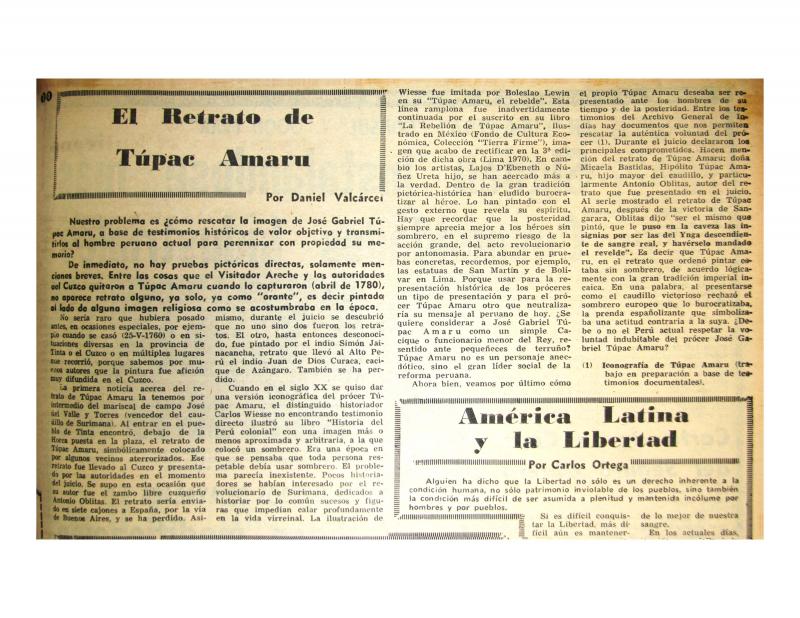This article was published after a letter to the editor of the same newspaper, also written by Manuel Araníbar, was discussed in the “El ojo ajeno” column on January 18, 1971. It is an interesting example of how passionate the debate on the image of Túpac Amaru II became during the military regime under Juan Velasco Alvarado (1910–77). The use of religious images, such as the “Contemporary Social Christ” to describe the Andean hero is striking. Indeed, in a later article by Peruvian journalist Juan Paredes Castro, Túpac Amaru II is called a “saint” because he died defending his ideals (La Crónica newspaper, March 20, 1971) [on that subject, see in the ICAA digital archive by Paredes Castro “En busca del retrato fiel del rebelde Túpac Amaru” (doc. no. 1141743)].
José Gabriel Condorcanqui, Túpac Amaru II (1738–81), was a curaca or chief of Incan descent who, in 1780, led the most important Andean uprising against the Spanish empire. Largely ignored by traditional Spanish-American historiography, his figure was the emblem of the so-called Gobierno Revolucionario de las Fuerzas Armadas during its first period (1968–75), which was characterized by social reform and by an interest in symbolic representation. The lack of portraits from the lifetime of the indigenous leader led to the organization of this competition [see in the archive by Alfredo Arrisueño Cornejo “Convocan a concurso de pintura para perpetuar la imagen plástica del mártir José Gabriel Condorcanqui” (doc. no. 865422)], whose jury included leaders of almost all the art institutions in Peru. The polemic nature of the competition was heightened by the dramatic decision not to award any of the works submitted [see also by Alfredo Arrisueño Cornejo “Declaran desierto el Concurso de Pintura ‘Túpac Amaru II’” (doc. no. 865498)]. Milner Cajahuaringa (1932–2017), one of the four painters awarded an honorable mention, decided to publicly renounce the recognition in a letter [see “Carta de renuncia a la Mención Honrosa otorgada en el Concurso de Pintura Nacional sobre Túpac Amaru” (doc. no. 1141759)]. A second competition was proposed, however, it was never held.
[For further reading on Túpac Amaru II, see the following articles in the archive: by General EP Felipe de la Barra “¿Cómo fue Túpac Amaru?” (doc. no. 865441); (unsigned) “Convocan a concurso: monumento a Túpac Amaru se levantará en el Cuzco” (doc. no. 1053438); (unsigned) “En busca de la imagen arquetípica de Túpac Amaru” (doc. no. 865702); by Daniel Valcárcel “El retrato de Túpac Amaru” (doc. no. 1052165); and by A. O. Z. “Túpac Amaru: ¿verdadero retrato?” (doc. no. 865460)].









